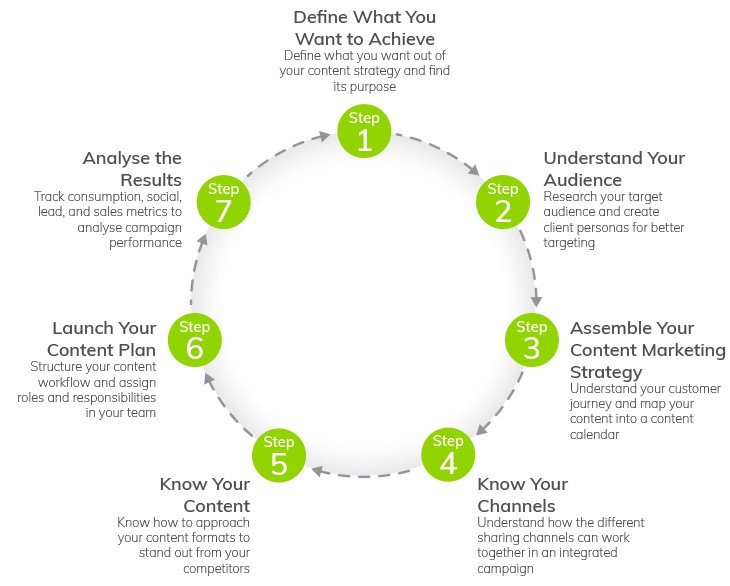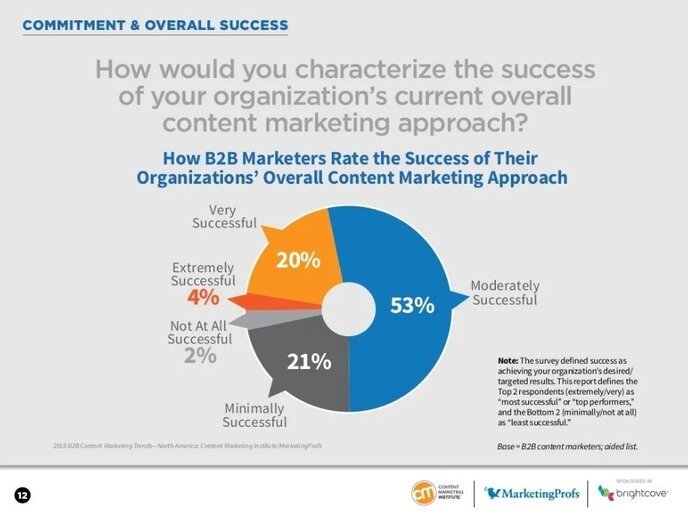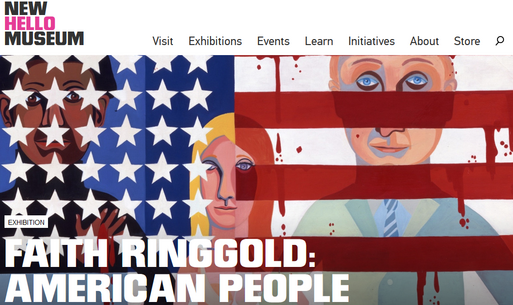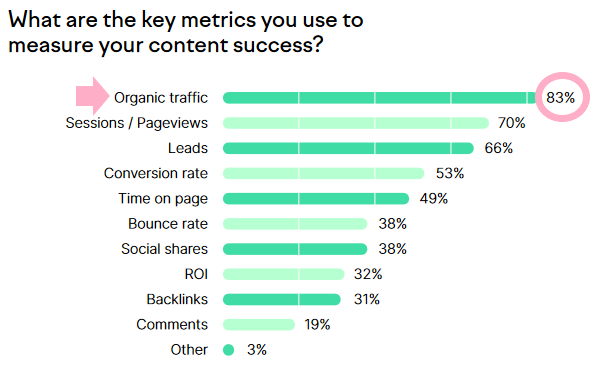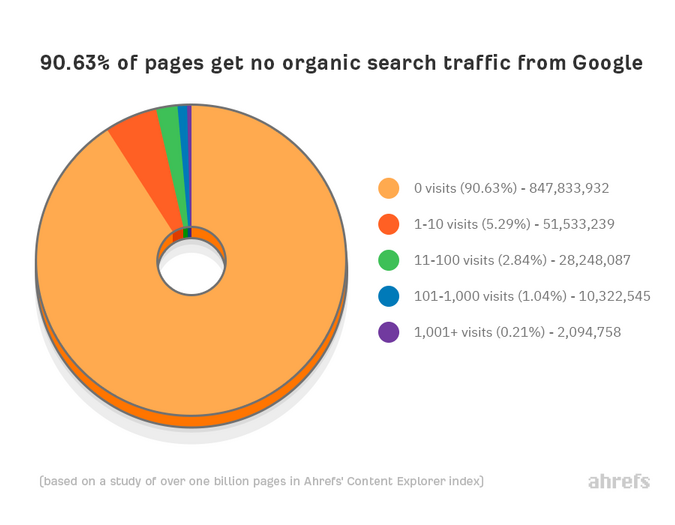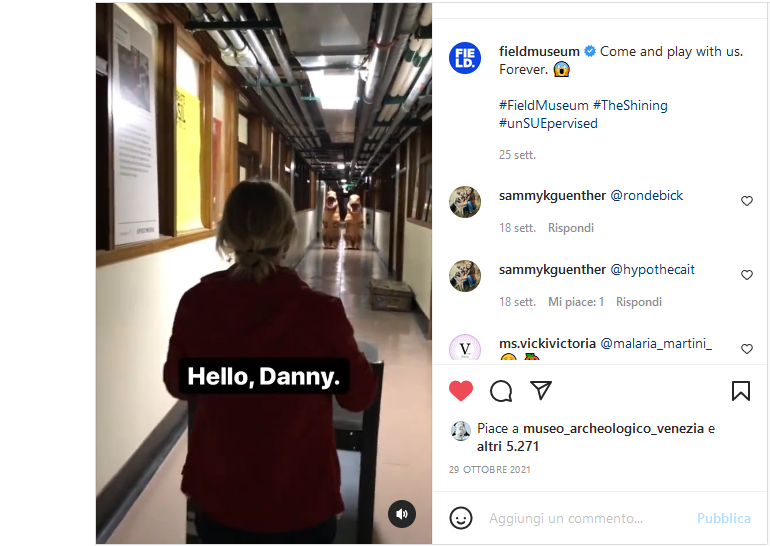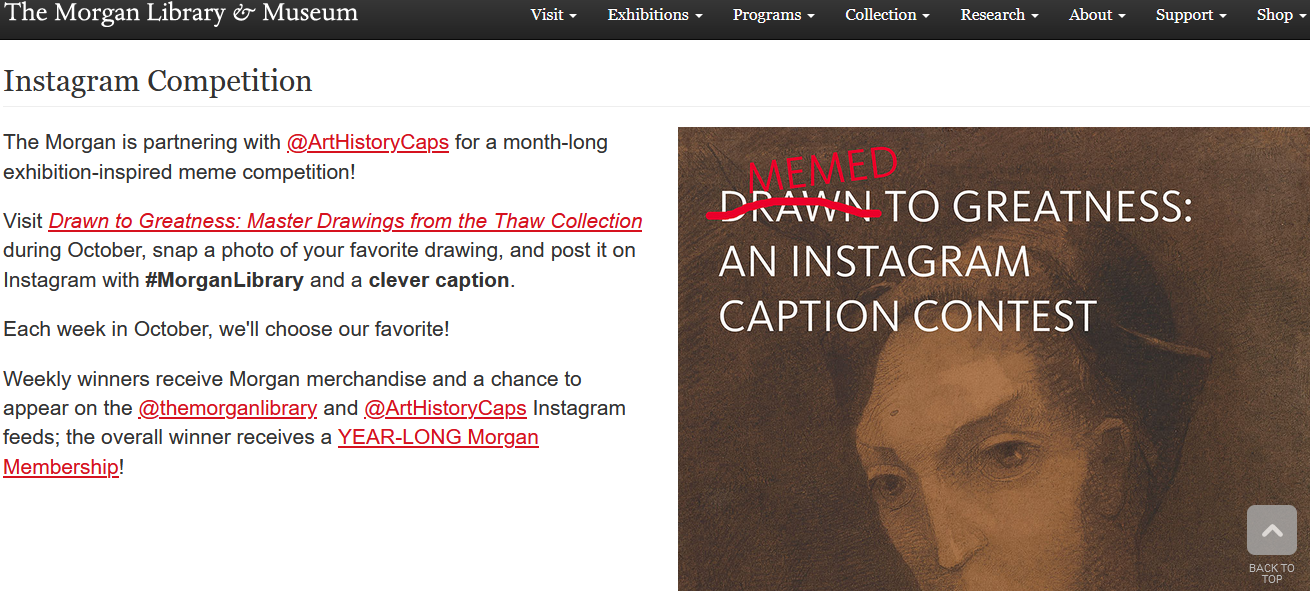Content Marketing for Museums: How to Get Started
If you’re looking for a successful method to develop your digital presence, foster audience engagement, and drive sales, you should start doing content marketing.
Integrating content marketing into your museum online activities makes all the difference.
Two facts for you:
82% of marketers actively use content marketing. (HubSpot State of Marketing Report, 2021)
68% of them planned on increasing their budget in content marketing in 2021. (IMPACT)
Due to the pandemic, businesses have made large investments in building a content marketing strategy.
Why?
Because content marketing has proven to be one of the most effective ways to promote and grow a business.
With social distancing, lockdowns, and remote working, human interactions have turned digital; hence, relying on online content has become a global need.
This change involves museums too.
81% of larger museums have increased their digital services as a result of the COVID-19 pandemic, while only 47% of smaller museums indicated that they did. (NEMO)
If you’re one of those museums wavering about investing in digital content marketing, you’re in the right place.
Let’s explore what content marketing is and the benefits of producing consistent, high-quality content that brings success. 💯
Content Marketing for Museums - Table of Contents
What Is Content Marketing?
Why Use Content Marketing for Museums?
7 Content Marketing Benefits for Museums
What Is Content Marketing?
Content Marketing is a form of marketing that revolves around creating, publishing, and distributing content that attracts and engages with a target audience online.
With relevant, useful content, you help people solve their pain points and fulfill their needs.
Content that works for your museum and audience is a powerful tool for boosting brand authority, engagement rate, and visibility.
According to the State of Inbound report, 80% of marketers see content creation as a top priority - meaning that content marketing has become a necessity for almost all businesses, regardless of their niche.
The content marketing lifecycle. (Everlytic)
Investing in a content marketing strategy is by no means a winning choice.
If you put the time and effort into educating, inspiring, and building trust with your audience, you’ll reap great results - it’s just a matter of patience, consistency, and strategic mindset.
Another important aspect of content marketing is storytelling.
As a museum, you already do this through exhibitions, art events, educational programs, and such; you plan and create content for diverse audiences, and deliver it through offline channels.
But with content marketing, you extend your activity online, providing informative, unique, and engaging content to worldwide communities.
“Museums have long focused on engagement and storytelling, but the role of content marketing is broader and asks the question: How do we drive a more meaningful experience for the people we want to reach and keep people engaged with this experience?”
Content marketing’s winning drive infographic. (CMI)
Content marketing involves…
Web pages
Blog posts
Social media
Email copy
Ad and sales copy
Creative content (visuals, videos, ebooks, podcasts, etc.)
…and represents the best strategic method to build relationships with people.
Why Use Content Marketing for Museums?
Producing meaningful, consistent content has a huge impact on how to market a museum; but you need to know what the best way is to achieve your marketing goals.
You probably asked yourself these questions multiple times: How do I market my art museum? How can I reach my audience effectively? How do I develop a strong museum branding?
The answer is… content marketing!
Here’s a few reasons why you should include it in your museum marketing activity:
Content marketing helps big and small businesses drive traffic to their website and rank better in the Google search results.
It works well for both B2B and B2C businesses.
It’s a practical approach to engaging with the target audience and creating a tight-knit community.
It’s useful to build brand loyalty, improve conversions, and generate leads.
Offering valuable, online content enables your museum to attract more visitors/customers and generate more sustainable income.
Content marketing is, in fact, thrice as effective at generating leads than outbound marketing while costing a whopping 62% less. (Demand Metric)
It yields promising results when executed correctly with a well-documented content strategy at hand (according to Content Marketing Institute, 63% of businesses don’t have it, although it’s essential to a successful marketing workflow).
Content marketing requires time, perseverance, and flexibility; but in the long run, it’ll skyrocket your museum!
7 Content Marketing Benefits for Museums
Now that you know what content marketing is and why it’s important for your museum’s endeavors, it’s time to understand how it’ll stand you in good stead.
Here are the top seven benefits of content marketing that will radically change your museum marketing and strategy.
Remember: your biggest goals won’t be out of reach with successful quality content.
Let’s dive in!
1. Raise Brand Awareness
Brand awareness represents how familiar your target audience is with your museum and how well they know you.
It’s not just about your name or logo.
Real brand awareness implies that your audience recognizes your museum’s identity and personality, as well as what sets you apart from the competition.
82% of consumers prefer to buy from a brand they know and trust already – regardless of where it ranked on the SERP. (Econsultancy)
This is extended to museums as well.
Depending on how you present yourself (your values and mission) and the types of services/events/programs offered, you can make better connections with visitors and motivate them to see your museum multiple times.
Content marketing is highly effective in building brand awareness: align your brand with your content to garner the attention you deserve.
By doing so, every piece of branded content will enable you to:
Strengthen your museum’s reputation and exposure.
Write about topics your audience is interested in.
Form authentic relationships.
Sell your values, rather than products.
Focus on engaging, relevant content that speaks to people and tells them who you are - this way, you’ll give them a reason to choose you and purchase your services!
Trust’s influence over large purchase decisions. (Marketing Charts)
Here are some tips on how to use content marketing for museum brand awareness:
Understand your target audience (Who are they? Where do they spend time online? What are their pain points?).
Build a content strategy (What’s your story? What type of content and channels will you use? How often will you publish content?).
Curate your museum blog to have a voice in your field.
Use social media to promote your content.
Send email newsletters to engage with the audience.
Analyze your results to improve content performance.
2. Generate Online Authority and Trust
By consistently creating educational online content that provides valuable answers to your audience's questions, you will…
Stand out as an industry expert.
Be seen as a credible place to learn from.
Rank higher in search engines.
Gain the trust of your audience.
The more quality content your potential visitors/customers read, the better they’ll get to know your museum; they’ll have a positive association with your brand and a strong bond.
Content marketing means publishing content that’s not sales-focused: what matters is to care about your audience and their problems, rather than just making the sale.
Once you have demonstrated your expertise and authority, people will naturally return to your website, blog, or social media. Not only will they feel encouraged to visit your museum in person, but also to invest in your online and offline services.
Source: MDS Digital Media
Google states that expertise, authoritativeness, and trust (E-A-T formula) are three key factors in how the algorithm ranks content. Following this formula when creating content will positively impact your online authority.
Common traits of authoritative content:
Consistent (qualitative content that is posted frequently).
Credible (content based on clear evidence and results).
Altruistic (content that prioritizes the audience’s interests and needs).
Accurate (content based on relevant information, data, and statistics in the industry).
Practical (content that provides real answers and effective solutions).
Include these aspects in your content creation to be seen as an expert and a trusted voice.
3. Build Your Own Brand
Content marketing is a powerful tool for museum branding.
By sharing your expertise, values, and services through quality content, you build a credible, trusted brand that keeps your museum thriving, and boost your visibility, relevancy, and trustworthiness.
Existing and potential visitors will clearly understand your museum’s overarching message and vision; they’ll learn about your identity and connect with you.
Good branding doesn’t just entail a logo, tagline, or your social media accounts; it has to do with the way you interact with the audience and how the latter sees you.
Use content marketing to…
Stand out from the competition by positioning yourself as an authority in your field.
Connect with the audience by telling the story of your brand (who you are and what you stand for).
Reach wider audiences by creating insightful content that resonates with them (they’ll want to engage more, visit your museum, and buy from you).
Make your brand memorable by building an emotional connection with the audience (you’ll stick in their minds).
Keep showing up by sharing content consistently (you’ll generate customer loyalty).
See two examples of museums who have branded themselves successfully:
1. Rijksmuseum
From 2003 to 2013, one of the most iconic museums of Amsterdam underwent a significant makeover and rebranding involving the design of the popular logo. The long renovation became an opportunity to relaunch the museum's identity and rekindle people's interest.
2. New Museum of Contemporary Art
With the opening of a new building in 2012, the museum took the occasion to rebrand itself. From the eye-catching architecture to the style of the logo and use of the recurring word “new”, the rebrand project aimed to invite people to explore the overhauled museum - with the new identity launch, visitors increased by 600%!
4. Drive Organic Growth
Content marketing is the most cost-effective marketing strategy available for your museum.
Instead of investing in paid ads (inorganic growth method) to make your brand appear on the web, with organic growth, you invest in content creation to attract leads and build your audience through relevant content.
Organic growth allows you to leverage your:
Expertise and authority
Reputation
Relationship with your target audience
Existing resources and skills
83% of marketers measure the success of their content based on organic traffic. (The State of Content Marketing 2020 by SEMrush)
Even if paid growth seems the quickest solution for your business, this is not sustainable in the long run!
You need to incorporate organic strategies into your marketing plan: create a well-structured website and valuable content production.
Several benefits come from this:
Useful content drives traffic for years to come.
Evergreen content triggers lead generation.
Organic search drives traffic to your website (the “house” of your best content).
Organic search builds brand awareness and thought leadership.
Organic search improves audience engagement and encourages organic visitors to explore your website.
Developing useful, high-quality content is key to your organic success since Google aims to return the most relevant results for a query (remember the EAT formula!).
This explains why only 5.7% of web pages ranked in Google’s top 10 search results within a year of being published. (Ahrefs)
To rank high on the first page of the SERPs, consider what Google looks for:
Relevant SEO content (content centered around focus keywords).
Links back to your website (how popular your website is among others).
Social signals (shares and traffic indicating people like and trust you).
Click-through rate and time on site (good content is rewarded).
Create strategic content to take advantage of Google’s SERP features, and you’ll stand every chance to grow organically.
5. Increase Audience Engagement
Content marketing ensures your visitors/customers are engaged with your museum.
Creating quality content is a powerful way to cut through the noise and keep the audience interested, inspired and committed.
It’s about the experience you provide and the emotional bond you trigger.
According to Salesforce, 95% of customers say that if they trust a company, they’re more likely to be loyal patrons.
You have a strong relationship with the audience when the latter enjoys what you offer, sees you as an authority in the industry, and consistently interacts with your content (through clicks, links, comments, shares, referrals, purchases, etc.).
Audience engagement allows you to:
Enhance customer trust and loyalty.
Amplify brand awareness and social reach.
Differentiate yourself in the market.
Increase website traffic and sales.
Grow your museum.
Humanize your brand and make it more personable.
To achieve these goals, devise a content marketing strategy around your audience.
Make sure to:
Tell a story that is authentic, relatable, entertaining, and educational.
Be easily found online by using specific keywords that attract the right prospects.
Commit to your audience by showing up on a regular basis.
Show your personality through empathetic content.
Here are two museums who have found inventive ways to boost their engagement:
1. Field Museum
The fun-loving dinosaur SUE has become popular on Instagram for her hilarious clips on the museum and its peculiarities (new events, exhibitions, collection highlights etc.), getting over 30K views and 3K likes per video.
2. The Morgan Library & Museum
In 2017, the museum launched a contest to urge the audience to see the new exhibition and related artworks - a creative way to harness the power of digital content for better engagement!
6. Ignite Lead Generation and Conversions
A solid content marketing strategy for museums takes your lead generation to new heights!
Content Marketing Institute reports that 80% of B2B marketers consider lead generation to be the top goal of their content marketing efforts; whereas another 70% demonstrate, with metrics, how content marketing has increased audience engagement and the number of leads.
Content is key to developing long-lasting relations with your current and potential visitors/customers. It influences conversions, helps your audience connect with you, and provides them with meaningful solutions and services.
Consumer-centric content is fundamental: place your audience’s needs above your promotional goals and align your content strategy with their expectations to maximize your CRO efforts.
But how do you generate leads and conversions through content marketing?
Look at these smart ways to win your audience’s attention:
Develop a buyer persona (content must suit your ideal visitor and deliver value for them).
Choose the type of content you want to share (blog posts, social media posts, videos, podcasts, etc.).
Create lead magnets to build your email subscriber list (webinars, ebooks, guides, etc.).
Use organic distribution channels (search engines, YouTube, Instagram, Twitter, LinkedIn, etc.).
Optimize your website’s landing pages (with impactful headline, clear CTA button, specific keywords, appealing visuals, etc.).
Keep these guidelines in mind to make the most of your contentin your lead-generation strategy.
7. Boost Your Social Media Engagement
Reaching a high social media engagement rate means making an impact in your field and having significant interactions with your audience.
This is possible with content marketing.
87% of B2B marketers use social media to distribute content, and 41% consider social media posts one of the most effective types of content for content marketing purposes.
Social media engagement is more than just advertising. It’s about engaging with your followers and keeping the conversation flowing.
“If NASA is able to help people better understand rocket science through social media, museums should rise to that same challenge.”
Activity and engagement are at the core of a positive brand experience through social platforms.
Both aspects are measured by an array of metrics:
Comments
Likes
Shares
Followers
Click-throughs
Tags
Hashtags
But to have an engaged, faithful audience - not just a big one - you need to aim at the quality of your content.
83% of marketers believe the quality of social media posts is more important than the quantity. (HubSpot)
A balance between quantity and quality is key to content marketing success. (Scoop.it)
To leverage your museum’s social media engagement:
Analyze the level of engagement.
Get to know your audience.
Evaluate the types of content you create.
Optimize the formats.
Write valuable content around topics that interest your audience.
Make your content more shareable.
Be proactive to spark conversation.
Show your human side with content.
This way, you'll have better traction on social media, meaning more shares, more engagement, and a boosted reach.
Many businesses - including museums - don’t see much traction despite their huge following: be different and use content marketing to your advantage!
Content Marketing for Museums: The Key to Long-term Success
There you have it - the top seven content marketing benefits for your museum!
After learning what content marketing is, why to approach it, and how to integrate it into your museum marketing and strategy, you’re fully equipped with the necessary insights to make the most of content marketing.
The benefits I’ve presented here are just a few ways engaging quality content helps you increase your online presence, generate growth, and make your museum branding successful.
If you’re still debating whether content marketing is the answer to your biggest challenges, look at these stats:
92% of content marketers say their organization views content as a business asset. (Content Marketing Institute)
The global content marketing industry is expected to generate a revenue of $137.2 million by 2026. (Research Dive)
There’s no better time to start investing in content marketing for museums.
So, roll up your sleeves and pave the way to success with content! 😉



